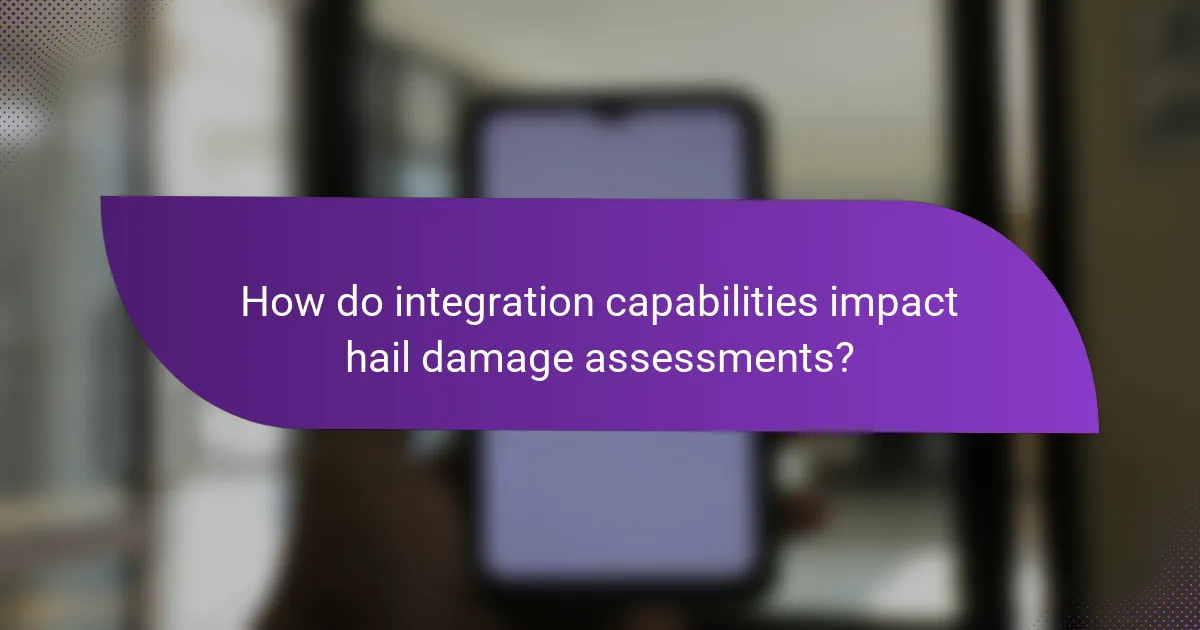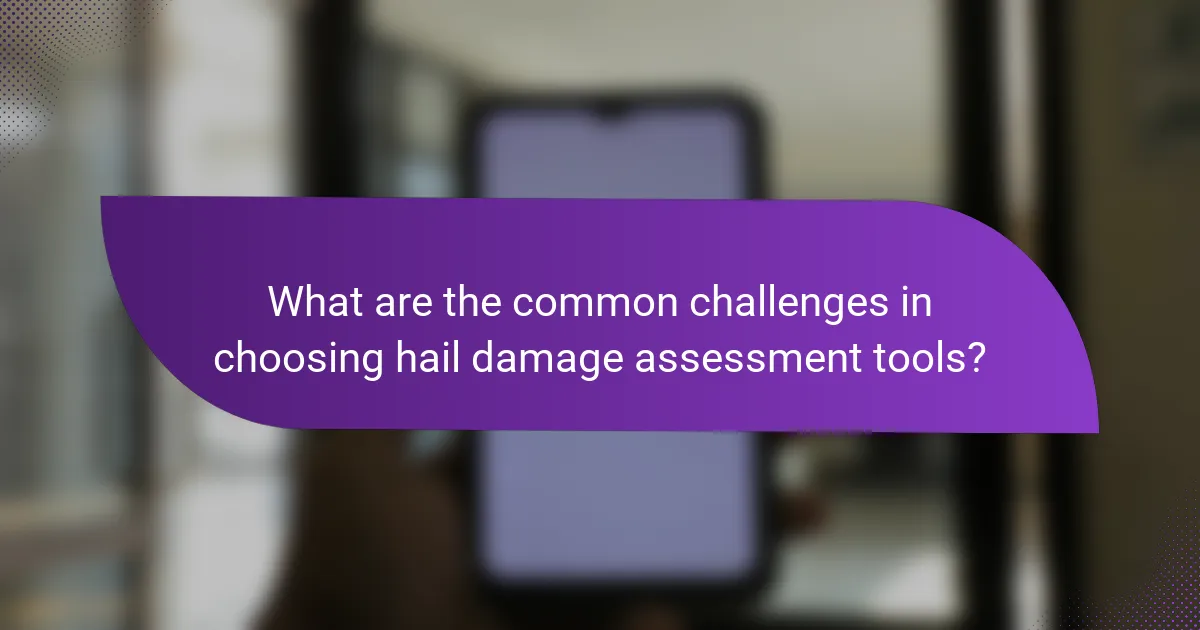Choosing the right hail damage assessment tools requires careful consideration of their integration flexibility. Tools that seamlessly connect with existing systems, such as HailTrace and AccuWeather, enhance data accuracy and streamline workflows. Prioritizing features like API access and user-friendly interfaces will ensure efficient damage assessments and better decision-making.

What are the best hail damage assessment tools for integration flexibility in Ireland?
The best hail damage assessment tools for integration flexibility in Ireland include options that seamlessly connect with existing systems and provide comprehensive data analysis. Tools like HailTrace, AccuWeather, CoreLogic, RoofSnap, and Hover offer various features that enhance their adaptability and usability in assessing hail damage.
HailTrace
HailTrace is a robust tool that specializes in providing detailed hail event data, including storm paths and intensity. Its integration capabilities allow users to connect with CRM systems and insurance platforms, making it easier to manage claims and assessments.
When using HailTrace, consider its user-friendly interface and the ability to generate customizable reports. This flexibility can significantly streamline the assessment process for contractors and insurance adjusters alike.
AccuWeather
AccuWeather offers reliable weather data and forecasts, which can be crucial for assessing hail damage. Its integration flexibility allows users to incorporate real-time weather updates into their existing systems, enhancing decision-making processes.
Utilizing AccuWeather can help users anticipate hail events and prepare accordingly. Its extensive data coverage across Ireland ensures that users receive accurate and timely information, which is essential for effective damage assessment.
CoreLogic
CoreLogic provides comprehensive property data and analytics, which can be invaluable for hail damage assessments. Its integration capabilities allow for seamless data sharing with insurance and real estate platforms, facilitating efficient claims management.
When choosing CoreLogic, focus on its extensive database and analytical tools that can help identify risk factors associated with hail damage. This can lead to more informed decisions and improved assessment accuracy.
RoofSnap
RoofSnap is designed specifically for roofing professionals, offering tools for measuring roofs and assessing damage. Its integration flexibility allows users to connect with various project management and estimation software, streamlining workflows.
RoofSnap’s mobile application enables on-site assessments, making it easier to capture data quickly. This feature is particularly useful for contractors who need to provide immediate estimates after a hail event.
Hover
Hover uses advanced technology to create 3D models of properties, which can be beneficial for assessing hail damage. Its integration capabilities allow users to share these models with insurance companies and contractors, enhancing collaboration.
By leveraging Hover’s 3D modeling, users can visualize damage more effectively, leading to more accurate assessments. This tool is especially useful for those in the roofing industry looking to provide detailed reports to clients and insurers.

How do integration capabilities impact hail damage assessments?
Integration capabilities significantly enhance hail damage assessments by enabling seamless data exchange, improving accuracy, and facilitating comprehensive reporting. Tools that can easily integrate with existing systems allow for more efficient workflows and better decision-making.
Streamlined data sharing
Streamlined data sharing is crucial for effective hail damage assessments. Tools that integrate well with other platforms can automatically exchange information, reducing the need for manual data entry and minimizing errors. For example, a hail assessment tool that connects with a claims management system can instantly update claims with relevant damage data.
When choosing tools, look for those that support common data formats like CSV or XML, and consider APIs that allow for real-time data sharing. This can save time and improve the overall efficiency of the assessment process.
Improved accuracy
Improved accuracy in hail damage assessments is often a direct result of effective integration capabilities. When tools communicate seamlessly, the risk of data discrepancies decreases, leading to more reliable assessments. For instance, integrating weather data with damage reports can help validate claims and provide a clearer picture of the impact.
Consider tools that utilize machine learning algorithms to analyze integrated data, as these can identify patterns and anomalies that might be missed in manual assessments. This added layer of analysis can enhance the precision of your evaluations.
Enhanced reporting
Enhanced reporting is a significant benefit of using tools with strong integration capabilities. These tools can compile data from various sources into comprehensive reports, making it easier to present findings to stakeholders. For example, a tool that integrates with GIS systems can generate visual reports that highlight affected areas and damage severity.
When selecting assessment tools, prioritize those that offer customizable reporting features. This allows you to tailor reports to specific audiences, ensuring that the information is relevant and actionable. Additionally, check for options that support automated report generation to save time and reduce manual effort.

What features should I look for in hail damage assessment tools?
When selecting hail damage assessment tools, prioritize features that enhance integration flexibility, such as API access, third-party integrations, and user-friendly interfaces. These elements ensure that the tools can seamlessly connect with your existing systems and improve overall efficiency in damage assessment.
API access
API access is crucial for integrating hail damage assessment tools with other software systems. A well-documented API allows for easy data exchange, enabling users to automate processes and reduce manual entry errors. Look for tools that offer RESTful APIs, as they are generally more flexible and easier to work with.
When evaluating API access, consider the rate limits and data formats supported. Tools that allow for high-frequency requests and support common formats like JSON or XML will provide greater versatility in integration.
Third-party integrations
Third-party integrations expand the functionality of hail damage assessment tools by connecting them with other applications, such as CRM systems or project management software. Assess the range of integrations available, focusing on those that align with your operational needs. Popular integrations include cloud storage services and analytics platforms.
Ensure that the tool you choose can easily integrate with the software you already use. This compatibility can streamline workflows and enhance data accuracy, ultimately improving your damage assessment process.
User-friendly interfaces
A user-friendly interface is essential for ensuring that team members can efficiently navigate hail damage assessment tools. Look for intuitive designs that minimize the learning curve and allow users to quickly access key features. A clean layout with clear navigation can significantly enhance productivity.
Consider tools that offer customizable dashboards, enabling users to tailor their experience based on specific roles or tasks. This personalization can help prioritize relevant information and streamline the assessment process, making it easier for teams to collaborate effectively.

How do pricing models vary for hail damage assessment tools?
Pricing models for hail damage assessment tools can differ significantly based on the flexibility and features they offer. Understanding these models helps users select the most cost-effective option that meets their specific needs.
Subscription-based models
Subscription-based models typically charge a recurring fee, which can be monthly or annually. This approach often provides users with continuous access to the latest features and updates without additional costs. For instance, a subscription might range from $50 to $200 per month, depending on the level of service and tools included.
When considering a subscription, evaluate how often you will use the tool and whether the ongoing costs align with your budget. Some services may offer discounts for longer commitments, which can be beneficial for regular users.
Pay-per-use options
Pay-per-use options allow users to pay only when they utilize the hail damage assessment tool, making it a flexible choice for those who need the service infrequently. Costs can vary widely, often ranging from $10 to $50 per assessment, depending on the complexity of the evaluation required.
This model is ideal for users who want to avoid ongoing fees and only incur costs when necessary. However, be mindful of potential high costs if assessments are needed frequently, as these can add up quickly.
Tiered pricing structures
Tiered pricing structures offer different levels of service at varying price points, allowing users to choose a plan that fits their specific needs. For example, a basic tier might cost around $30 per month, while premium tiers could exceed $150, offering advanced features like detailed reporting and analytics.
When selecting a tier, assess your requirements carefully. Opt for a higher tier if you anticipate needing advanced features or frequent assessments, but ensure that the additional costs are justified by the benefits you will receive.

What are the common challenges in choosing hail damage assessment tools?
Choosing hail damage assessment tools often involves navigating compatibility issues, data security concerns, and the learning curve for users. These challenges can significantly impact the effectiveness and efficiency of the assessment process.
Compatibility issues
Compatibility issues arise when hail damage assessment tools do not integrate well with existing systems or software. This can lead to data silos, where information is trapped in one system and cannot be easily shared or analyzed with others.
To avoid these problems, assess the compatibility of tools with your current platforms before making a decision. Look for tools that offer APIs or support common data formats to facilitate smoother integration.
Data security concerns
Data security is a critical consideration when selecting hail damage assessment tools, especially if sensitive information is involved. Tools that do not adhere to industry standards for data protection can expose your organization to risks such as data breaches or unauthorized access.
Ensure that any tool you consider complies with relevant regulations and has robust security features, such as encryption and user authentication. Regularly review the security protocols of your chosen tools to maintain data integrity.
Learning curve for users
The learning curve for users can significantly affect the adoption and effectiveness of hail damage assessment tools. Tools that are overly complex may require extensive training, which can delay the assessment process and reduce overall productivity.
Choose tools that offer user-friendly interfaces and comprehensive training resources. Consider platforms that provide tutorials or customer support to help users become proficient quickly, minimizing downtime and enhancing efficiency.

How can I evaluate the effectiveness of hail damage assessment tools?
To evaluate the effectiveness of hail damage assessment tools, consider their accuracy, integration flexibility, and user-friendliness. These factors will help you determine how well the tools can meet your specific needs in assessing hail damage.
Assessing Accuracy
Accuracy is crucial when evaluating hail damage assessment tools. Look for tools that provide reliable data through validated algorithms or historical data comparisons. Tools that utilize machine learning or AI can enhance accuracy by learning from past assessments.
For practical evaluation, consider testing tools against known damage cases. This can help you gauge their precision and reliability in real-world scenarios. Aim for tools that demonstrate high accuracy rates, ideally above 80% in assessments.
Integration Flexibility
Integration flexibility refers to how well a hail damage assessment tool can work with other systems and software. Choose tools that can easily integrate with existing platforms, such as CRM systems or insurance software, to streamline workflows.
Check if the tool supports APIs or has built-in connectors for popular software. This can save time and reduce errors when transferring data. Tools that offer customizable integration options are often more adaptable to your specific operational needs.
User-Friendliness
User-friendliness is essential for ensuring that your team can effectively utilize the assessment tools. Look for intuitive interfaces and clear instructions that facilitate quick learning and adoption. Tools that offer training resources or customer support can also enhance usability.
Consider conducting a trial period with potential tools to assess their ease of use. Gather feedback from team members to identify any challenges they face. Prioritize tools that minimize the learning curve and allow for efficient operation.
